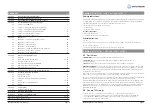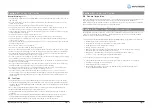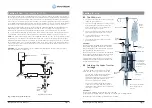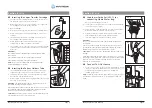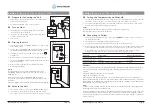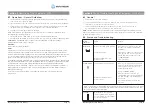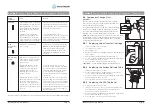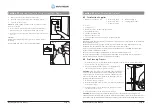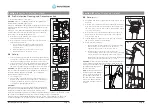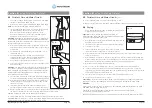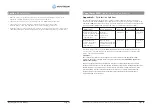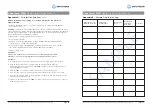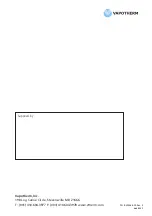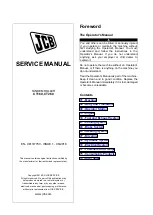
Section 1
Indications and Contraindications
Primary Indications:
Used to warm and humidify breathing gases, generally prescribed during oxygen therapy where concentrations
of oxygen greater than ambient air are utilized to treat symptoms and manifestations of hypoxia including:
• Documented hypoxemia: decreased Pa0
2
in blood below normal range
• Acute care in which hypoxemia is suspected
• Severe trauma
• Acute myocardial infarction
Secondary Indications:
• Managing hypothermia
• Treating bronchospasm caused by cold air
Contraindications:
General:
• Any situations in which humidification is contra-indicated (see AARC Clinical Practice Guidelines)
Specific to Nasal Cannula:
• Patients with occluded or defective nares should not use the system.
Section 2
Definitions, Warnings and Cautions
2.1
Definitions
A
WARNING
indicates that a potentially harmful situation may occur.
A
CAUTION
indicates a condition that may lead to equipment damage, malfunction, or
inaccurate operation.
A
NOTE
indicates a point of emphasis to make operation more efficient or convenient.
ASEPTIC TEChNIqUE
is practices and procedures performed under carefully controlled conditions with
the goal of minimizing contamination by pathogens. Specifically with respiratory equipment, especially
with reference to the Vapotherm 2000i, this includes proper hand washing and avoiding direct hand
contact with connection points.
Please take the time to familiarize yourself with the definitions, warnings, cautions and notes listed in this
manual. They cover safety considerations, special requirements, and regulations.
The user of this product assumes sole responsibility for any malfunction due to operation or maintenance
performed by anyone not trained by Vapotherm™ staff or official training documentation.
When handling any part of the Vapotherm
®
2000i, always follow hospital infection control guidelines and
Standard Precautions. Vapotherm recommends that users follow the disinfection procedure found in this
manual. Vapotherm also recommends that users follow the Centers for Disease Control (CDC) publications:
Guidelines for Maintenance of In-Use Respiratory Therapy Equipment and Guidelines for Prevention of
Nosocomial Pneumonia.
2.2
General Warnings
• Federal Law (U.S.) restricts the sale of this device to, or by the order of any physician.
• This is a humidification device generally used for providing continuous flows of breathing gas.
The
Vapotherm
®
2000i
is not a ventilatory device and should not be used as life support.
• This device will not operate without flow.
Operating Instruction Manual
Page 3
Operating Instruction Manual
Page 2
Contents
Page
Section 1
Indications and Contraindications
3
Section 2
Definitions, Warnings and Cautions
3
Section 3
About Vapotherm
™
2000i Product Description
5
Section 4
General 2000i Set up and instructions
4.1
Set Up – The 2000i Unit
7
4.2
Set Up – Selecting the Vapor Transfer Cartridge
7
4.3
Set Up – Inserting the Vapor Transfer Cartridge
8
4:4
Set Up – Inserting the Patient Delivery Tube
8
4:5
Set Up – Vapotherm Spike Set (VSS-1)
9
4:6
Set Up – Connect to a Gas Source
9
Section 5
Operations
5:1
Operations – Prepare for Activating the Unit
10
5:2
Operations – Turn on Flow
10
5:3
Operations – Priming the Unit
10
5:4
Operations – Activate the Unit
10
5:5
Operations – Setting the Temperature and Warm-Up
11
5:6
Operations – Connecting to a Patient
11
5.7
Operations – General Guidelines
12
Section 6
Alarms and Troubleshooting
6.1
General
13
6.2
Alarm and Troubleshooting Table
13–14
6.3
Component Change-outs
15
6.3.1
Replacing the Vapor Transfer Cartridge
15
6.3.2
Replacing the Patient Delivery Tube
15
6.3.3
Replacing the VSS-1 Spike Set
15
Section 7
Removing From Patient and System Shut Down
16
Section 8
Routine Disinfection Procedure
8.1
Disinfection Supplies
17
8.2
Pre-cleaning Process
17
8.3
Pre-disinfection Cleaning and Decontamination
18
8.4
Set-up
18–19
8.5
Disinfect Gas and Water Circuits
20
8.6
Drying
21
Section 9
Specifications
22
9.2
Definitions and symbols
22
Section 10
Warranty Information
23
Section 11
Reference and Bibliography
24
Appendix A – Disinfection Solution
25
–
26
Appendix B – Sample Disinfection Log
27


